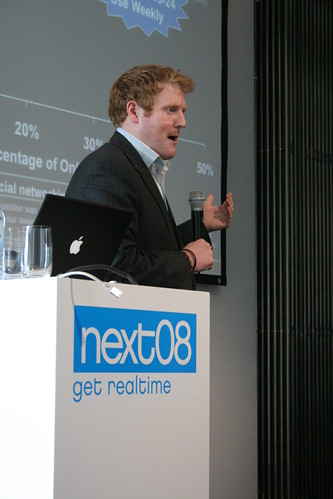We’re here to learn how to use social media to engage your target audience – which happens to be the subtitle of this panel, too. Why is this so important? Consumers are spending massive amounts of time on social networking sites like Facebook, MySpace or StudiVZ. (For exact figures, you’ll have to ask Jupiter Research.)

Even in Europe, where we lag behind the U.S. in terms of social networking use, there’s a very strong trend towards engaging stronger and more often in social networking services. Same goes for other kinds of social media, like for example weblogs.
And in all those places, consumers people talk about brands. This, of course, can be pretty scary for enterprises: The discussion has moved to a place where companies and marketers have very little control over the conversation. So becoming part of that conversation is important for brands and marketers, and it’s hard, if you try with the traditional marketer’s mindset.
What’s even harder is measuring success: There are basically no reliable, established and proven metrics to measure the kind of engagement you encounter in social networking sites. Without metrics, though, there can’t be evaluation, so marketers cannot prove their success, or find out why a campaign was not successful. These metrics is what Jupiter Research is after.
Nate Elliott shows, for the first time, the new Rules of Social Marketing:
#1: Your Messages Aren’t Going to Promote Themselves
For an Intel campaign, Jupiter found a direct connection between traffic&engagement and paid advertising. When paid ads stopped, traffic died.
#2: Focusing on Engagement Can Double Your ROI
MySpace and Facebook aren’t your brand microsite. Different rules apply in social networks, many marketers forget that. Great example of how not to do it: A promo site on Facebook for the most recent Rambo movie showed just the trailer, no interactive elements at all – it was just a microsite, not a real social networking format. Please do engage your audience.
#3: If You’re Not Measuring Results, You’re Wasting Your Money
Elliott shows to ways to measure results, even though neither of them is perfect. It’s either surveys (which measure beliefs) or technology (which measures actions). Either way, you need to have goals, and metrics to measure, in order to reach your goals.
(One hint Elliott gave right in the end: If you’re planning to rely on viral alone, you’re as good as doomed. Just don’t do that.)
Great workshop – I just added Nate Elliott on Twitter.